Ngā Hau e Whā means the the Four Winds
. The name is symbolic of being a meeting place for all peoples from everywhere. Situated in Pages Road, Bromley, Ngā Hau e Whā National Marae forms a gateway from the nearby east coast into the City. The extensive palisade running the perimeter of the complex allows only an obscured view of the impressive Wharenui and Whare Wānanga that lie beyond the grand carved gateway to the South Island’s first National Marae.
What is a National Marae
A Marae is a place of learning, celebration, ceremony and meeting. It is traditionally the focal and social point of Māori community. The political and economic climate of the 1950s led to a mass movement of Māori from rural areas into the cities — many Māori were forced to leave behind not only their marae, their tūrangawaewae, but also their whānau and culture. Urban marae were established in cities as multi-tribal meeting places that would enable Māori to maintain links with their culture and identity. Urban marae also offered the opportunity to generate cultural understanding among non-Māori.
The concept of a National Marae takes this idea further. Ngāi Tūāhuriri who hold Manawhenua in the Ōtautahi region, extended their tūrangawaewae to include not only all the tribes of New Zealand but all the peoples of New Zealand regardless of tribal affiliation, religion, geographic reference or ethnicity. Ngā Hau e Whā National Marae is the only Marae in New Zealand to be founded on this model.
Norm Dewes speaks about about the protocols of Ngā Hau e Whā and its status as a National Marae
History
In 1848 when Ngāi Tahu Māori sold most of Canterbury to the New Zealand Company for 2,000 pounds they were promised reserve lands to cater for their present and future needs. Subsequent to this deal however no reserves were surveyed in Christchurch and Māori cultivations and settlements were lost. In 1858, the Canterbury Provincial Government granted Little North Hagley Park as a Māori reserve but no funds were available so a building was never erected. From 1862 Māori were permitted to tether their horses in Little North Hagley Park but the Government wanted the land back in 1872 and agreed to find another site to replace it. It seems nowhere was found and subsequently confusion arose over the ownership of this land. From that time, local Māori continually sought a site in the city for use as a meeting and resting place. The Christchurch National Marae project grew out of this history and the Ngā Hau e Whā Trust was set up in the 1960s with the dream of building a National Marae.
A National Marae in Christchurch
 By the late 1970s, the idea of establishing a National Marae had gained widespread support. Ngāi Tahu elders, other prominent Māori leaders and Pākehā supporters of the project became involved in negotiations with the Christchurch City Council to obtain land for a Marae. While the gifting of a Marae site by the City Council would not directly compensate for the historical loss of promised reserve lands, it was regarded as a gesture in this direction. From a Council perspective, the need for a Marae in Christchurch was precipitated by growth in the urban Māori population of the city and increased interest in traditional Māori heritage, arts and culture. A National Marae would provide both a meeting place for Māori and a place where all New Zealanders could be educated about Māoritanga.
By the late 1970s, the idea of establishing a National Marae had gained widespread support. Ngāi Tahu elders, other prominent Māori leaders and Pākehā supporters of the project became involved in negotiations with the Christchurch City Council to obtain land for a Marae. While the gifting of a Marae site by the City Council would not directly compensate for the historical loss of promised reserve lands, it was regarded as a gesture in this direction. From a Council perspective, the need for a Marae in Christchurch was precipitated by growth in the urban Māori population of the city and increased interest in traditional Māori heritage, arts and culture. A National Marae would provide both a meeting place for Māori and a place where all New Zealanders could be educated about Māoritanga.
Early proposals for a Marae site included suburban sites in Humphries Drive and part of Hansen’s Park in Opawa. There was also some support for the Marae to be sited centrally, in Hagley Park. Christchurch City Council established a Marae development fund in July 1977 at which time a site for the Marae had not yet been agreed upon. In September 1977 at a meeting at Te Rangimārie Centre, the Marae Committee accepted a Christchurch City Council offer of an extensive site in Aranui — Cuthbert’s Green. Some elders voiced concern about the proximity of the site to the Bromley Sewerage Plant however a sense of urgency accompanied the desire to secure a site and the offer was ultimately accepted. In spite of strong opposition from a local community group the Marae project went ahead.
Cuthbert’s Green Site
The site consisted of a roughly grassed paddock with some gentle rolling sand dunes and occasional depressions. There were scattered pines on the site and an established plantation on the western boundary. The Marae Committee spent a year setting up Ngā Hau e Whā Christchurch Marae Inc., a legal body that was able to accept the land.
Christchurch City Council provided free architectural and engineering services. Council architects drew up schemes for the Marae buildings and fundraising began. The Māori Affairs Department offered a dollar for dollar subsidy for the first $100,000 and the Labour Department offered subsidised temporary work schemes. Gifts and promissory notes came from all over the country. A special meeting of all tribes was held at Tuahiwi Marae in June 1979 to discuss names for the Marae Ātea, Wharenui, and other Marae buildings and to give final consent to the Marae plans.
Handing Over Ceremony
Once permission to build the Marae was granted, the land was handed over as a gift from the City of Christchurch. On 26 October 1980 a handing over ceremony was held. The Tapu was placed by Mr Hohua Tutengaehe on the land where the thirty metre long wharenui would be built. The tapu would not be lifted until the building was completed, as is customary in the building of wharenui. The Mayor of Christchurch, Hamish Hay handed over the title deed for the 4.23 hectare site to the Board of Trustees for the National Marae. The site was then dedicated by ministers of various denominations.
By this time, the Trustees had raised $100,000 towards the building fund. The estimated overall costs were $1.1m to $1.2m. It was anticipated that construction of the Marae would take five years. Ngā Hau e Whā Board members, weavers and carvers toured all the major North Island tribal Marae to gain consent for their plans to place representations of Pākehā ancestors alongside ancient tribal tūpuna in the wharenui. Each marae chose tūpuna to be represented in the wharenui. Weavers recorded the construction methods, patterns and stories told in the tukutuku panels of the marae they visited. The extensive consultation process was a unique and symbolic act that reflected the sentiment behind the meaning of the name Ngā Hau e Whā — The Four Winds.
The consultation process for establishment of the Marae
A Marae is Born
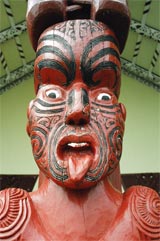 Construction of the Marae began in 1981. A Kokiri Centre of Māori Crafts was set up on site near the frontage to Pages Road in several temporary buildings donated by the Education Board. The Kokiri Centre incorporated workshops and storage facilities and enabled the public to see the work of wood carvers and weavers who were working on the marae. The Centre became a major tourist attraction.
Construction of the Marae began in 1981. A Kokiri Centre of Māori Crafts was set up on site near the frontage to Pages Road in several temporary buildings donated by the Education Board. The Kokiri Centre incorporated workshops and storage facilities and enabled the public to see the work of wood carvers and weavers who were working on the marae. The Centre became a major tourist attraction.
It is significant that the majority of the work at Ngā Hau e Whā was done by previously inexperienced craftsmen and women. Trainee carvers and weavers with an aptitude for highly skilled work and a desire to be part of the National Marae project were employed at the marae under Government subsidised training programmes. Carvers trained and worked under the instruction of master carver John Rua. A weaving school led by Mrs Ramari Brennan trained the weavers who produced tukutuku panels for the wharenui. Other weavers of piu-piu, tāniko, korowai and kete also trained at the Kokiri Centre.
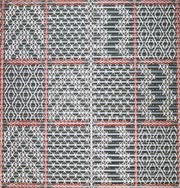 In 1982 there were approximately 100 people working on site at Ngā Hau e Whā. The diverse gathering of people working on the project created a community atmosphere that was reflected in official correspondence where the Pages Road site was referred to as the Pā. The Ngā Hau e Whā project gave many Māori the opportunity to work for the first time with other Māori on a quintessentially Māori project where participants were rewarded and valued for expressing and living their culture.
In 1982 there were approximately 100 people working on site at Ngā Hau e Whā. The diverse gathering of people working on the project created a community atmosphere that was reflected in official correspondence where the Pages Road site was referred to as the Pā. The Ngā Hau e Whā project gave many Māori the opportunity to work for the first time with other Māori on a quintessentially Māori project where participants were rewarded and valued for expressing and living their culture.
The first carving completed was a large mural that remains a feature of the dining room. Individual carvers worked on whakairo that represented their own tūpuna. Carvings for the whare wānanga were completed first before they began work on the native timbered traditional pou for the wharenui. Te Amorangi, the striking carved gateway to Ngā Hau e Whā National Marae, was opened in 1982, well before the eventual completion of the rest of the Marae complex.
By 1985, $7 million had been spent on the marae. Ambitions for what could be achieved at the marae had grown and the project stalled several times due to financial and political problems. In 1987, the project went into liquidation; the property transferred to the Government and became crown land, administered by the Ministry of Māori Affairs. The Ngā Hau e Whā dream progressed and the Marae was eventually completed and officially opened in May 1990 by the then Minister of Māori Affairs, Koro Wetere. Representatives from Iwi throughout New Zealand were present at the opening celebrations.
Many notable kaumātua of the Christchurch community led the Ngā Hau e Whā project including Rongo Nihoniho, Wahawaha Stirling, Hori Brennan, Hohua Tutengaehe and Tipene Manihera. Christchurch City Council, the Department of Labour, the Department of Māori Affairs, the local business community and community organisations all contributed talent, resources and enormous energy to seeing the facilities at Ngā Hau e Whā to completion. The fully carved wharenui, Aoraki, with its beautiful Tukutuku panels, kōwhaiwhai and tōtara carvings remains the largest of its kind in New Zealand. The Whare Wānanga named Te Aritaua Pitama stands to the right of Aoraki and the dining hall, Taranga (named for the mother of Maui), extends out behind the two whare. A carved pouhake erected in memory of Māori who died in the wars stands to the left of Aoraki and the Marae Ĕtea is surrounded by thousands of pickets that form a grand palisade.
Ngā Hau e Whā National Marae
The Elders' vision for the marae and the job ahead for Maata Waka as the new Management for Ngā Hau e Whā Marae
Since its opening Ngā Hau e Whā has been used as a centre for culture, education and entertainment. In 1993 it was recognized by NZQA as a private training establishment that ran courses in employment skills, hospitality, crafts and Māori art and carving. In 1995 a tourist attraction called ‘A Night of Māori Magic’ opened at the marae. A tour programme was offered to schools and tourists and the facilities were made available for functions, conferences and exhibitions.
The viability and sustainability of projects at the marae have historically proven a challenge and the beauty and intent of Ngā Hau e Whā have at times been overshadowed by financial, political and administrative problems. Ngā Hau e Whā National Marae was originally envisaged as a facility which could bring the community together and enrich Christchurch and New Zealand’s social and cultural life. In 2005 Ngā Hau e Whā National Marae came under the management of the urban Māori authority, Te Rūnanga O Ngā Maata Waka which plans to take the marae in new directions and has vowed to bring to realisation the potential of Ngā Hau e Whā and fulfill the dreams of those who were instrumental in its formation.
The Earthquakes of 2010 and 2011.
The devastation wrought in Christchurch after the earthquakes of 2010 and 2011 was especially severe for those people living in the eastern suburbs of the city. With Ngā Hau e Whā National Marae located in Aranui the marae was a crucial part of the city’s response to the quake.
The marae has been an important centre for delivery of services and resources that were needed in this area of Christchurch. With the centre of the city cordoned off many organisations have had to be innovative and there have been a number of agencies based at the marae to assist people in need following the quakes. With the closure of the central city law courts the marae trustees provided a temporary home for the Justice Department law courts until May 2013. The marae provided a special atmosphere to the legal proceedings taking place there and will be remembered by those involved there.
Sources
- Thank you to Bill Karaitiana, Dave Brennan, Norm Dewes, Riki Pitama and Aroha Reriti-Crofts for contributing information for this document.
- Dewes, Norm. Interview by Helen Brown. DAT recording, Nga Hau e Wha National Marae, Christchurch, 31 October, 2005.
- The Press 1975 — 2005
- Riley, Brett. Gone with the four winds, NZ Listener, March 5, 1988, p16-17
- The Journey of the Four Winds: Nga Hau E Wha National Marae, 2000
- Christchurch City Council Archives. CH344: Nga Hau e Wha National Marae 1976 — 198? [Including site diaries, correspondence, original plans and submissions]
- Christchurch City Council Building Files: Nga Hau e Wha National Marae, Pages Road
The Buildings
Find out more about the Marae Buildings at Ngā Hau e Whā National Marae:
 Te Amorangi
Te Amorangi
The prominent carved lintel that marks the gateway and entrance to Ngā Hau e Whā National Marae is called Te Amorangi and was officially unveiled on 7 November 1982 by the then Governor General Sir David Beattie. At the opening, the Minister of Māori Affairs, Mr Ben Couch said The gateway, once the last line of defence, is now the first line of welcome for those from all tribes and races who come to Ngā Hau e Whā in respect and friendship.
(Press 8.11.1982)
 The central panel at the top of the arch represents the spirit of Te Tiriti o Waitangi. The manaia figure has a contorted body that writhes in two different directions symbolising the never-ending debate that surrounds the Treaty. The Treaty panel is flanked by two large carved figures who are Governor William Hobson (who represented Queen Victoria at the Treaty signing in 1840) and a Māori Rangatira who is representative of three of the seven Ngāi Tahu chiefs who signed the Treaty — Taiaroa, Karetai and Korako who were the most active chiefs in defending what later became the rohe pōtae of Ngai Tahu. (Other Ngai Tahu chiefs who signed the Treaty were Iwikau, Tikao, Kaikoura and Tūhawaiki.) These figures signify the bringing together of Māori and Pākehā at the National Marae. The curved arch represents the rainbow and the carved figure at the top, the atua, Kahukura. Below is a large ornately carved waka manned by figures representing the captains of the principal canoes that brought Māori to Aotearoa. The two carved figures below the archway represent Ngā Hau e Whā, the four winds.
The central panel at the top of the arch represents the spirit of Te Tiriti o Waitangi. The manaia figure has a contorted body that writhes in two different directions symbolising the never-ending debate that surrounds the Treaty. The Treaty panel is flanked by two large carved figures who are Governor William Hobson (who represented Queen Victoria at the Treaty signing in 1840) and a Māori Rangatira who is representative of three of the seven Ngāi Tahu chiefs who signed the Treaty — Taiaroa, Karetai and Korako who were the most active chiefs in defending what later became the rohe pōtae of Ngai Tahu. (Other Ngai Tahu chiefs who signed the Treaty were Iwikau, Tikao, Kaikoura and Tūhawaiki.) These figures signify the bringing together of Māori and Pākehā at the National Marae. The curved arch represents the rainbow and the carved figure at the top, the atua, Kahukura. Below is a large ornately carved waka manned by figures representing the captains of the principal canoes that brought Māori to Aotearoa. The two carved figures below the archway represent Ngā Hau e Whā, the four winds.
Aoraki
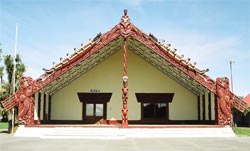 Aoraki is the name of the Wharenui and recalls the creation story of the South Island whereby the highest peak, Aoraki was hoisted from beneath the ocean. The Wharenui is strongly about Pacific identity; its carvings and symbolism reflect the geographical and geological histories of New Zealand and its place in the Pacific Ocean. The multi-tribal nature of the Wharenui is revealed through a study of its carvings.
Aoraki is the name of the Wharenui and recalls the creation story of the South Island whereby the highest peak, Aoraki was hoisted from beneath the ocean. The Wharenui is strongly about Pacific identity; its carvings and symbolism reflect the geographical and geological histories of New Zealand and its place in the Pacific Ocean. The multi-tribal nature of the Wharenui is revealed through a study of its carvings.
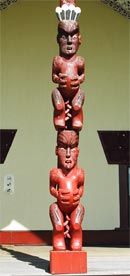
The history of the frontage of Aoraki brings together the history of Māoridom including the whole of Polynesia. All tribes whakapapa back to Maui who is the tekoteko atop the house. He is symbolically pulling in all the people as represented in the two waka on the maihi that extend below him. The waka represent the canoes of Maui, Māhunui. The central poukaiāwhā on the verandah represents two Waitaha ancestors Waitaha (shown with feathers on his head) and below him, Rakiura the Waitaha leader who settled on Stewart Island.
The maihi depict the two great whirlpools of the Pacific Ocean, Te Korokoro a Parata (Throat of the Parata) and Te Hohou Rongo. The Ngārara (lizards) on either side signify the danger of the ocean and their breathing creates the tides. The kōruru at the centre, represents Tautahi after whom Ōtautahi (Christchurch) is named.
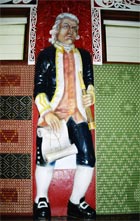 The verandah is lined with whakairo representing ancestors who are mostly carved in the Te Arawa style. Ancestors featured include Kupe (who was the first to land here), Ngahue (who accompanied Kupe in his waka and from whom pounamu originated) and Waitaha (referring to the original inhabitants of the country). Hine nui te Pō is on the pare (lintel) above the door. Other ancestors include Hine moana a Kiwa (Guardian of the Pacific Ocean), Ra kaihautū (of the Uruao Waka), Rapuwai and Toi te Huatahi.
The verandah is lined with whakairo representing ancestors who are mostly carved in the Te Arawa style. Ancestors featured include Kupe (who was the first to land here), Ngahue (who accompanied Kupe in his waka and from whom pounamu originated) and Waitaha (referring to the original inhabitants of the country). Hine nui te Pō is on the pare (lintel) above the door. Other ancestors include Hine moana a Kiwa (Guardian of the Pacific Ocean), Ra kaihautū (of the Uruao Waka), Rapuwai and Toi te Huatahi.
Inside Aoraki the carvings include not only Māori ancestors but also the European ancestors Captain Cook and Able Tasman. Carving styles from throughout Te Waka ā Māui and Te Ika ā Māui are represented. Some of the work incorporates a blend of styles within a single pou creating a multi-tribal carving style.
The carvings include representations of many important warriors, explorers and tribal leaders including important tohunga. Among them are Ngāi Tahu ancestors Ruahikihiki, Te Rakiwhakaputa, Mako and others who symbolize the beginning of the Ngāi Tahu migration, Marukore and Tūhaitara (whose union formed the beginning of the Ngāti Māmoe migration) and Tahu Pōtiki (eponymous ancestor of Ngāi Tahu).
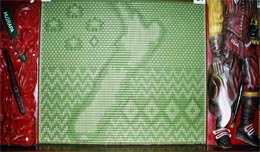 Other ancestors represented are Ranginui (the sky father), Hipo (Captain of the waka, Arai Te Uru), Waewae (an explorer of the West Coast) and Tamatea Pōkai Whenua (the explorer whose name is recalled in the Māori term for the Port Hills — Ka Kōhatu Whakarakaraka o Tamatea Pōkai Whenua meaning,
Other ancestors represented are Ranginui (the sky father), Hipo (Captain of the waka, Arai Te Uru), Waewae (an explorer of the West Coast) and Tamatea Pōkai Whenua (the explorer whose name is recalled in the Māori term for the Port Hills — Ka Kōhatu Whakarakaraka o Tamatea Pōkai Whenua meaning, the smouldering boulders of Tamatea Pōkai Whenua
). The poutokomanawa at the centre of the wharenui represents Paora Tau, a more recent Ngāi Tahu ancestor responsible in a team of three for bringing the Ngāi Tahu Claim, Te Kerēme. This figure represents the beginning of Ngai Tahu’s fight for redress from the Crown.
Both end walls of the Wharenui feature whakairo that are a collection of tribal leaders. The tukutuku panels utilize traditional and modern approaches to design in identifying key icons all over the South Island of importance to Ngāi Tahu.
Te Aritaua Pitama
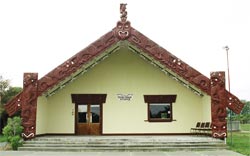 The Whare Wananga is named Te Aritaua Pitama after the well respected Māori broadcaster. Te Aritaua Pitama is similar to Aoraki in its emphasis upon a South Pacific identity and geographical and geological history. The tekoteko is Ngahue who is flanked on either side of the whare by his two wives Hine Pounamu (the Mother of Pounamu) and Hine Poupou (who represents the sea floor between the North and South Islands.)
The Whare Wananga is named Te Aritaua Pitama after the well respected Māori broadcaster. Te Aritaua Pitama is similar to Aoraki in its emphasis upon a South Pacific identity and geographical and geological history. The tekoteko is Ngahue who is flanked on either side of the whare by his two wives Hine Pounamu (the Mother of Pounamu) and Hine Poupou (who represents the sea floor between the North and South Islands.)
The interior walls of the Whare Wananga are lined with whakairo representing the children of Rangi and Papa and geological stories. The carved pou graphically depict some well known Māori atua and traditional stories in brightly painted carvings of a
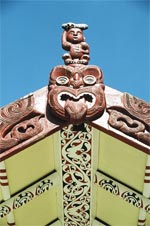
modern style. Among those represented are Tangaroa (Guardian of the Ocean), Poutini (Guardian of Pounamu), Rangi and Papa, Tāwhiri matea (the Wind), Tūmatatenga (Guardian of War), Te Tai rāwhiti (the Sun), Tane Mahuta (Guardian of the Forest) and Rehua (Guardian of Love). The stories of Tane going to the sky to get the three baskets of knowledge and of Paikea, the whale rider, are also depicted. Te Aritaua Pitama features a large carved mural that was gifted to the marae by carving students in 1998. Traditionally carved pou and tukutuku panels complete the interior decoration.
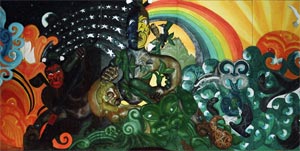
Pouhake
 The impressively carved Pouhake at Ngā Hau e Whā National Marae was erected in memory of Māori servicemen and women who fought in all our wars. The late Ropata Wahawaha Stirling, Ūpoko Rūnaka ki Ōtautahi made a pledge after World War II that he would honour and remember his fellow warriors who had not survived the horrors of war. As part of his commitment to this promise, he traveled to all the major battlefields to gather soil from each place which was then put into the earth at the base of the Pouhake.
The impressively carved Pouhake at Ngā Hau e Whā National Marae was erected in memory of Māori servicemen and women who fought in all our wars. The late Ropata Wahawaha Stirling, Ūpoko Rūnaka ki Ōtautahi made a pledge after World War II that he would honour and remember his fellow warriors who had not survived the horrors of war. As part of his commitment to this promise, he traveled to all the major battlefields to gather soil from each place which was then put into the earth at the base of the Pouhake.
The carver of the Pouhake was George Edwards of Wairewa. Tūmatatenga (Guardian of War) is at the base of the Pouhake, symbolically holding it up. Members of the Māori battalion and Māori men and women who fought in all wars since the Boer War are represented in the whakairo. On completion, the Pouhake was blessed and unveiled by Rev. Maurice Gray, Chairman of Ōtautahi Runaka. A piece of Pounamu from Arahura and a memorial plaque were installed near the base of the Pouhake in remembrance of those who served in these wars. The seating at the base of the pou bear the military insignia of the 28th Māori Battalion, the New Zealand Army, The Royal Navy, The Merchant Marine and the Airforce.
A memorial service is held annually, the weekend before Anzac day, at Ngā Hau e Whā National Marae in remembrance of servicemen and women who have died.
Following the 2010 and 2011 earthquakes in Canterbury the marae was used for criminal court hearings until the court buildings in the city were available again.
